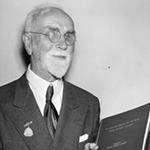Some patients like to tell stories and reminisce when they are in the chair. And these tales inevitably become embellished in the retelling. We smile politely, only half listening, while we peruse their records or make notes. So when a new patient started describing how, as a young girl growing up in Halifax, Nova Scotia, a kindly old gentleman used to take her out into the bay on rowing trips, it seemed of limited interest. Until she recounted the incident that occurred one foggy day.
Jane, as we will call her since she wishes to remain anonymous, recalled the episode with a vividness as bright as the glint in her eyes, given that it all happened well over 50 years ago. The setting is Bedford Basin (pictured), a large bay joined by a long, narrow, neck of water to Halifax Harbour on the east coast of Canada. Jane’s family were well known in the area and well connected. Her mother was prominent in many local organisations, while her father had been a well-respected major in the Royal Canadian Engineers (RCE).
A close acquaintance of Jane’s family, Samuel Hussey, used to take her for walks in the woods and boat trips in the bay. On this particular morning fog was swirling around the bay as Hussey was preparing to take Jane out in his boat from his private jetty. Jane recalls clearly a large man suddenly shouting across to Hussey: ‘Hey, you! What are you doing taking that girl out in a rowing boat in this fog?’ Hussey replied calmly with his own question, ‘Sir, are you a visitor here?’
The man became more agitated. ‘Yes – what of it?’ he huffed. As the man became more heated in his protestations, the commotion drew the attention of Hussey’s son, John, to the scene. He was a captain in the RCE during World War II, possibly having joined the Corps through his family’s connection with Jane’s father. John attempted to placate the man by ensuring him that there was no problem – the situation was entirely safe. ‘But he can’t see!’ bellowed the man. ‘That’s precisely the point,’ returned Hussey junior. ‘He doesn’t need to see; he’s blind, so this is the safest time to go rowing as there are no other boats on the water. And you, sir, are trespassing.’
A blind man taking a girl rowing and for walks – could that really be true? Interest at last piqued, I decided to see if I could find out more about this Mr Hussey, who my narrator had thought had connections with the Halifax School for the Blind. It turns out that he was, indeed, a remarkable character.
A profile of Hussey featuring in the December 1953 issue of Atlantic Guardian, explains that ‘once he has visited a city and gets to know it, he never has any more trouble to find his way around. He gets around easily in Halifax, St John’s and Winnipeg, but finds Montreal more difficult.’ Returning to his childhood home nine years after leaving for Halifax, he had no difficulty at all locating all the places that had been familiar to him.

Bedford Basin from the air
That childhood home, where Samuel Robert Hussey was born in 1874, the grandson of an immigrant from Dorset who settled in Newfoundland in 1790, was the small town of South River. Located in modern day terms about 50 minutes west of St John’s along the Conception Highway, the settlement even today has only a population of around 750.
Aged nine, he suffered a severe case of scarlet fever that damaged his sight severely, ultimately leaving him totally blind. After much medical treatment the family had to accept that there was no hope of his vision being restored. The heartbreaking decision was made to enrol the now 12-year-old in the Nova Scotia School for the Blind (NSSB) in Halifax, over 100 miles away. Even as his ship was about to sail, his father called out, ‘Say the word Sam, and I’ll take you back home.’ Hussey never regretted his reply: ‘No! I’ll go, sir!’

She recalls the occasion, when walking along the street with him on their way out to their expedition, a burly sailor carrying a trunk barrelling towards them, as if late for his ship’s departure, shouting, ‘Out of the way!’ Jane remembers Hussey freezing stock still for a moment, then shoving her to one side just before the sailor crashed into him, knocking him flying. ‘What’s the matter – are you blind?’ cursed the sailor. Jane’s memory is of Hussey bursting into laughter at the absurdity of the situation, to her utter bemusement.
By all accounts Hussey’s good humour saw him through many unfortunate accidents. One such incident involved a fall down some stairs of almost 20 feet, landing painfully on his head. Another happened when he was showing reporters around a new wing of the NSSB then under construction. He stepped through an open door erroneously thinking there was scaffolding on the other side and fell eight feet to the ground.
Apart from a four-year period, Hussey’s teaching career was devoted to the Halifax school. In 1919 he moved to Winnipeg to teach, at the request of the Canadian National Institute for the Blind (CNIB). This was followed two years later by a stint in Montreal as superintendent for the Montreal Association for English.
He returned to Halifax in 1923 to resume his former position as head of the literary department at NSSB where he remained, rising to principal, until retirement in 1949. During that time he developed a new system for multiplication and the use of the Braille typewriter for mathematics. In 1933 he published a pamphlet describing his new system, Mathematical Notation: The Halifax Code, in which he describes his rationale for developing it as being to simplify, save space and use the minimum number of symbols.
He also became a Charter Member of the Maritime Association for the Blind on its formation in 1908, lending it his support until it affiliated to the CNIB, of which he in turn became an active member.
But Hussey was not always a model of good behaviour. Jane recalls many visits to his house. She remembers her mother whispering to her during one trip, ‘Uh, oh. He’s misbehaved; it’s the “Housekeeper’s Revenge!”’ The explanation of ‘Housemaid’s Revenge’ is in two parts.
The first is what Hussey had done to deserve it; the second as to its execution. As befitted a man of his position he entertained at home regularly, for which occasions his housekeeper would prepare delicacies for dessert the night before. Hussey clearly enjoyed entertaining out too; coming home late with an appetite fuelled with a certain amount of alcohol, he would find said delicacies and deplete their stock.
This inflicted the twin indignities on his housekeeper of having her hard work spoiled and embarrassment of being able only to serve a plain dessert to the next day’s guests. Now, Hussey’s wardrobe, like everything else, was meticulously organised, and he was always immaculately dressed. His sock drawer included some brightly-coloured pairs made from reclaimed wool knitted by local women as part of the war effort, and the housekeeper would put out an odd pair of these to gain her revenge. Hussey, of course, would never know; but she got her satisfaction.
Perhaps Hussey’s best legacy is the work he put into the Scholarship Fund, of which he was appointed convenor in 1951, set up under the auspices of the Maritime Division of the CNIB, having recognised that there was a need to help financially those blind and visually impaired children who wished to proceed to further education.
The Fund, which is still running, was renamed the SR Hussey Memorial Fund after his death in 1964. When I informed Jane of this discovery she was so delighted she insisted on sending a donation in memory of her old mentor and guide – an inspiration to many blind children and one sighted young girl.
